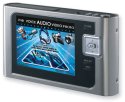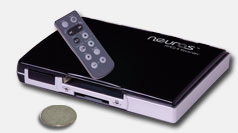Neuros solicits feedback on Linux-based PMP/R design
Oct 18, 2005 — by LinuxDevices Staff — from the LinuxDevices Archive — 1 views Neuros Audio has asked LinuxDevices.com readers to help define its next product, a Linux-based handheld portable media player/recorder (PMP/R) featuring audiophile-quality sound. The company says feedback is easiest to respond to early in the design, and calls its approach “the next step” in developing… devices with open-source software.
Neuros Audio has asked LinuxDevices.com readers to help define its next product, a Linux-based handheld portable media player/recorder (PMP/R) featuring audiophile-quality sound. The company says feedback is easiest to respond to early in the design, and calls its approach “the next step” in developing… devices with open-source software.
(Click here for larger view of the earlier Neuros 442)
 Neuros is best known for its 442 portable media recorder and player, a $400 device with a 40GB harddrive that can capture MPEG-4 video from DVD players, satellite TV, and other sources, and play it back on a 3.6-inch LCD, or to an external device. The company also makes “The Recorder” (photo at right), a similar device in a set-top box form factor.
Neuros is best known for its 442 portable media recorder and player, a $400 device with a 40GB harddrive that can capture MPEG-4 video from DVD players, satellite TV, and other sources, and play it back on a 3.6-inch LCD, or to an external device. The company also makes “The Recorder” (photo at right), a similar device in a set-top box form factor.
Neuros is currently designing a successor to the 442 portable media player, and has published the specifications for a development board that it calls the “first prototype.” Neuros invites hackers, open source software authors, and interested readers to review and weigh in on the design, which is expected to be finalized in about a week.
The new Neuros design is based on a Texas Instruments DM320 (TI) dual-core RISC/DSP chip with an ARM926 application processor clocked at 200MHz and a C54x DSP core clocked at “up to 120MHz,” the company says. The design supports up to 128MB of RAM, and 8MB of Flash.
The new device will run a Linux 2.6 kernel, according to Neuros CEO Joe Born.
I/O includes a 12Mbps USB host interface, as well as a USB gadget interface, a non-DMA (PIO only) IDE hard drive interface, CF interface supporting I/O, SD/MMC interface, 10/100 Ethernet, NTSC/PAL composite or S-video input, S-video output, and 10 user buttons.
Of special note in the design are a DAC and an ADC (digital-analog converter and analog-digital converter) from legendary audio chip house Burr-Brown. Burr-Brown chips are rarely if ever used in computing devices, let alone portable ones. However, they are probably the most popular sound chips in audiophile-quality stereo components such as standalone DACs and high-end CD players.
The design has line-level analog audio inputs only — maybe someone will suggest they add a microphone-level input, for those who might want to record live audio without the bulk of a pre-amplifier. The device also has line-level analog audio output, along with an S/PDIF (Sony-Philips digital interface) digital audio output.
Neuros says it has already solicited feedback from several online audiophile communities, and has already gone through four revisions of its development board. It says it believes that open product development “reflects the future of product development, because it draws important feedback at the earliest stages of the product's development, when it's the easiest to respond.”
“As engineers, most of us spent our academic careers in an environment where open peer review was just taken for granted as the most sensible way to advance science and technology,” said Born. “Once we transitioned to the business world, we were conditioned to accept that secrecy was a necessary evil. In fact, experience is showing us that peer review works great in the business world as well.”
“In our new platform, we have a device that's more powerful than a PC on some specialized video tasks: it has a dual-core processor that can play and record full DVD-resolution MPEG-4 video in real-time, Born continued. “It uses an audiophile 24 bit/96Khz audio processor and runs a Linux 2.6 kernel, and all on a board that costs about $100. It just stands to reason that hackers would want to play with it.”
More details, including a downloadable 18-page Word document describing the current development board specification, can be found here.
This article was originally published on LinuxDevices.com and has been donated to the open source community by QuinStreet Inc. Please visit LinuxToday.com for up-to-date news and articles about Linux and open source.